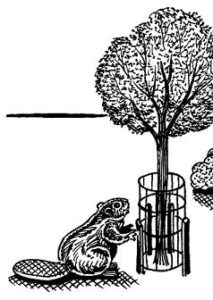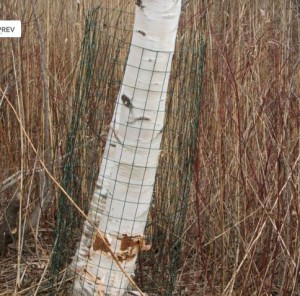In the 15-year history of this website I have written very few stories of Pennsylvania. Maybe a couple here and there,with beavers being trapped for chewing trees or causing flooding but this is the first WELCOME BEAVER! article I’ve read that I can recall. It’s not brimming with accurate information but we are soo darn happy it’s there at all I won’t complain. Say hello to Frick park.
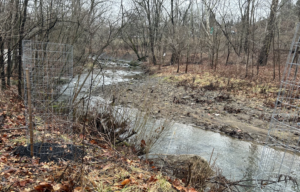 Frick Park’s newest resident is causing quite a stir. Wildlife fans and hikers have come to the park in the weeks since park rangers first spotted a beaver in late December, with hopes of stealing a glance.
Frick Park’s newest resident is causing quite a stir. Wildlife fans and hikers have come to the park in the weeks since park rangers first spotted a beaver in late December, with hopes of stealing a glance.
But like many others who came before, resident Jane Bernstein returned to the parking lot just off the Nine Mile Run trail unsuccessful. Since the flat-tailed mammal is nocturnal, Bernstein got to the park before 8 a.m. on a snowy Friday this January.
This wasn’t the first time she had gone to look for him, either.
“I went on a beaver walk with somebody from Nine Mile Run — a group — and that was great,” Bernstein said. “We learned a lot about how excited they are about the beaver, despite the fact that the beavers do gnaw down trees.”
Excited about the beaver! Imagine! Frick park is in an oasis of wooded steep trails in the middle of the city of Pittsburgh. It was a large estate bequeathed for a park in the early 1900’s by Henry Clay Frick an early founder of the Coke industry which was a treatment for coal that fueled iron smelting.
So I guess it’s kind of nice a fossil fuel’s founders tax write-off is happy to see beavers?
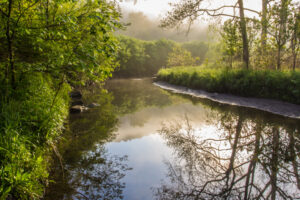 While elusive, the beaver, aptly nicknamed Castor — the North American beaver’s scientific name is Castor canadensis — leaves a pretty clear trail of pointed, jagged little sticks behind him.
While elusive, the beaver, aptly nicknamed Castor — the North American beaver’s scientific name is Castor canadensis — leaves a pretty clear trail of pointed, jagged little sticks behind him.
“You can see he’s been out munching around,” park ranger Erica Heide points out as she walks down a path parallel to the stream.
Castor is the second beaver to be spotted in the park in recent years, according to Heide. The first one appeared in Nine Mile Run in 2019, likely having migrated up from the Monongahela River, the waterway that sits at the mouth of the stream.
Heide said that the beaver stayed in the area for about a year, but no mates or kits (the term for baby beavers) were spotted with him.
“He moved on, we assume, for mating season,” Heide said.
So far, Castor has appeared alone at Nine Mile Run, too. Heide said while beavers are friendly within their family units, they’re territorial creatures, with just one family inhabiting a single section of a waterway at a time.
In any number, though, Heide said the presence of beavers is a sign of a healthy ecosystem where sewage and industrial waste once dominated.
“They are known as nature’s engineers,” she said enthusiastically. “They’re the only one of the only species that can change their environment and alter the hydrology.”
I would say the hardy beaver is a BRINGER of a healthy ecosystem – not exactly a sign of one. I mean there are beavers in Chernobyl and I’m pretty sure that’s not healthy. But still I get your point. They can do good things for the hydrology.
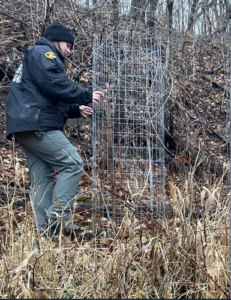 This years-long effort to detoxify the stream, led by the City of Pittsburgh and the U.S. Army Corps of Engineers, included rerouting the stream channel by adding curves and ripple rocks to slow down the water and the rate of flooding.
This years-long effort to detoxify the stream, led by the City of Pittsburgh and the U.S. Army Corps of Engineers, included rerouting the stream channel by adding curves and ripple rocks to slow down the water and the rate of flooding.
A decade and a half later, fish and beavers have continued the work of improving the surrounding wetland environment. For instance, beavers’ chomping habits can be useful in shaping a climate-resilient landscape.
“See how clustered and how tight they are,” Heide said pointing to a group of streamside willow branches. “That’s actually really bad. They’re even starting to uproot themselves because of how heavy they are.”
But beavers love to eat willows, which grow back once cut down.
“It will cut those down and then they can regenerate into like a healthier cluster,” she explained.
Doing so helps protect the stream bank from erosion. Heide said the parks plan to plant more willows this spring and will hold several willow staking events where residents can get involved.
To protect the trees they want Castor to stay away from, park rangers and conservation groups put protective cages around nearby trunks, prioritizing those that are young and native to the northeast, like oaks, aspens and maples.
Well I would rather have a team of beavers working on that stream than the army core of engineers, but honestly, I’m not sure about your statement that FISH helped the stream, That’s like saying cars help roads?
Heide said it’s unlikely beavers will ever build a successful dam on Nine Mile Run. During storm surges, the area is susceptible to intense flooding that dams would likely not withstand.
Still, if Castor or any other beaver in the park was able to complete a dam, Heide said it would be another step toward successful environmental restoration. For one thing, it can cause flooding that brings up nutrients and seeds from the water into the soil, sparking a surge in vegetation for wildlife to eat.
At the same time, dams can further reduce the rate of flooding by slowing down floodwaters while filtering out pollutants that travel downstream.
Well that’s no more than the truth. I think I like having a beaver welcoming committee strew their path with good news. And hey the name can’t hurt. “Heide” (Hmm even if she spells it wrong…)
Hiller said the organization hopes to continue that work to protect the health of habitats throughout the watershed and restore other parts of the park, like the Fern Hollow Valley.
The presence of a beaver, he added, is a sign that they are headed in the right direction. For those who want to see the beaver, Heide advises people not to get their hopes up.
“He’ll probably become more and more elusive as we get into the colder and colder weather,” she said. “Just like us, we don’t want to be out in the cold. Neither does he.”
In the event he is spotted, Heide stresses that people give him space, and keep any dogs in the park on leash.
“That will ensure that this beaver is safe for future years to hopefully come back.”
Gosh. I’m still waiting for the other shoe to drop. But I guess it’s darn cool that a industry giant’s park can be somewhere that is happy to have beavers. I’m pretty sure that wasn’t always the case.













